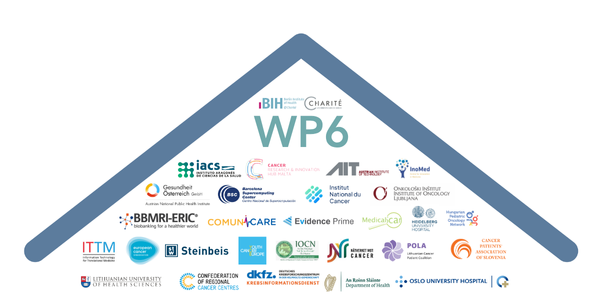At a glance
Central focus of WP6 is the development and deployment of the infrastructure and digital tools that facilitate collaborative content creation, review, and updating processes.

WP6 is led by BIH/CHA and contributed to by AIT, GOEG, IACS, HUPON, DoHIE, LSMU, INC, CRIHM, DKFZ, OUS, YCE, INOMED, cRCCS, OIL, CPAS, MESC, BBMRI-ERIC, ECO, SIG, UKHD, BSC, POLA, ITTM, EVP, IOCN, ComCare, NMC.
The task
European Cancer Patient Information Portals will provide patients with trustworthy, evidence-based information in their local languages. This serves as first step toward creating European Cancer Patient Digital Centres (ECPDC).
WP6 develops digital solutions, tools and infrastructure to support the ongoing management of content from a shared Library of Content, which is regularly provided to the participating Member States. The design, development, and distribution of these digital solutions form the core of EU-CiP’s value proposition: enabling a more effective way to build and sustain high-quality national and regional Cancer Information Portals within a cooperative network, rather than as standalone solutions.
Part of WP6 involves designing and developing a generic EU-CiP reference node. This includes the core node architecture and a Content Management System (CMS) core node architecture involving a CMS and the connectors/plugins to facilitate the content inclusion and interoperability. The reference node acts as a prototype and coordination hub for national and regional nodes.
Key components, stakeholders, and elements involved in the EU-CiP node design include:
- Evidence-based information, such as clinical guidelines and other high-quality, trustworthy data covering the entire patient journey—including side effects and long-term effects.
- The EU Knowledge Center on Cancer (KCC) as a primary source of evidence-based information.
- National Cancer Data Nodes (NCDNs), which are vital parts of the data infrastructure aligned with the CANDLE and the UNCAN Connect projects.
- Alignment with the EHDS Regulatory Framework and related initiatives to enable patient-centred, direct access to health information and data and to to ensure a proper data access control.
- Enhancing the usability of the Library of Content, including AI tools like a Large Language Model (LLM) chatbot, to make content more accessible and user-friendly.
